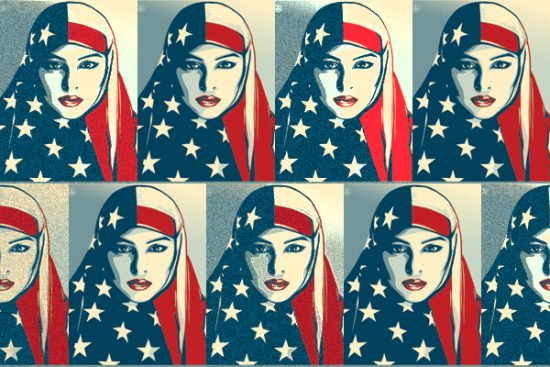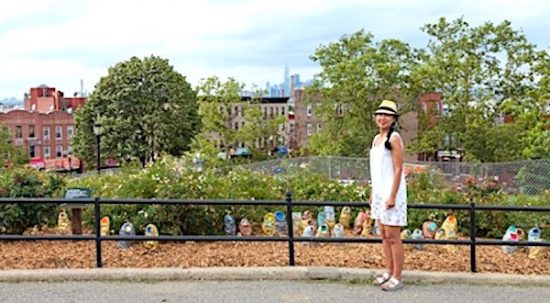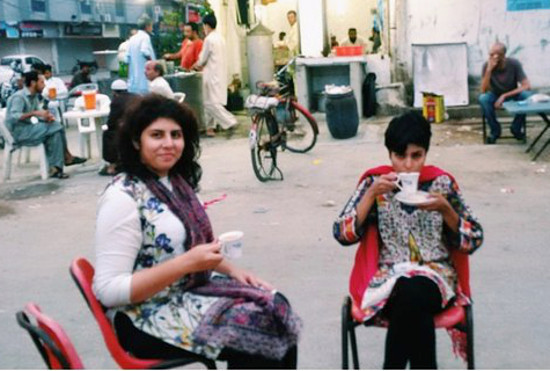Community organizers have created a walking tour of Jackson Heights that focuses on the experiences of the immigrants who live in the neighborhood.

December 20, 2016
Twenty college students, armed with their cameras, notebooks and backpacks, crowded the sidewalk in front of Delhi Heights, a restaurant in Jackson Heights, on the corner of 74th St. and Diversity Plaza. They were from the University of Toronto and on a five-day field trip for a class called New York City. The class description states:
“This field trip will investigate the re/making of New York City over the last five decades, with a focus on changing built form, economy, and social geography. The course will approach New York as a deeply contested and divided space that is undergoing both slow and dramatic transformation. One central lens on the city will be gentrification and a number of related processes such as the racialization, de-industrialization, segregation, and financialization of urban space.
“We will also continuously be asking about the politics and geographies of race, status, gender and sexuality. We will examine how uneven power relations and the different interests and desires of groups produce the contemporary urban landscape of New York. We will visit sites that have been focal points of conflict and change including Red Hook and the Gowanus Canal, lower Manhattan, Williamsburg and Bushwick, the Lower East Side, Jackson Heights, and The Bronx. We will meet up with community organizers and members of local communities along the way in order to learn from their experiences.”
Neha Gautam and Josselyn Atahualpa greeted the students. Neha is an educator, community organizer, and photographer, while Josselyn is an organizer for Queens Neighborhood United (QNU). I got permission to accompany the tour and write about it.
As a resident of Jackson Heights, I have been interested in the representation, documentation and storytelling of the neighborhood. So is Neha; she introduced herself as an immigrant who grew up in Jackson Heights. “I was born in India. My mother came to New York when I was 2 or 3. It’s a big part of my life and the stories I want to bring to the surface and the stories I want to know about,” she says.
Neha went on to say a lot of people know about Jackson Heights for different reasons. Some, she said, just hear about the “authentic” food and come here to eat. She also mentioned the draw of proximity to Manhattan, “It’s about three express train stops from Manhattan. So it’s about 20 minutes on the train to midtown Manhattan. There’s the LIRR, there’s the highway here. A lot of people, because of the convenience, want to be here,” Neha relayed.
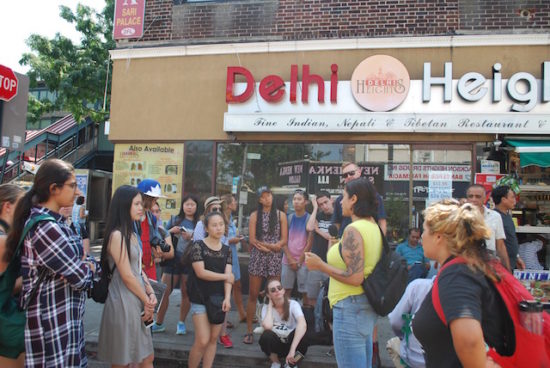
Indeed, from the 2015 profile of Jackson Heights in the New York Times real estate section which called Jackson Heights “diverse and evolving”, to the award-winning 2015 documentary, In Jackson Heights, by 86-year-old white American director, Frederick Wiseman, Jackson Heights is getting more and more attention as a desirable neighborhood to live in.
The buzz words are diversity, architecture, food, and location. When I heard about the walking tour, I felt it was a timely intervention to these emerging dominant narratives about Jackson Heights. Josselyn told me she cringed at the word “tour” and I immediately understood; most tours in Jackson Heights are related to food or of the private gardens of pre-war co-op buildings. And like tourism culture in general, the occupational segregation of local workers is normalized as is the inaccessible privileged dwellings of the neighborhood.
This tour – “The People’s Walking Tour” – from its conception, aimed to lift up the voices and experiences of “the people working behind those food stalls, behind those street carts, behind those small local restaurants,” as Amy Paul, who founded the tour, stated in a 2012 interview. Amy was a 2011 Coro Immigrant Civic Leadership Project Fellow when she started the tour. It was created in collaboration with three community-based organizations: Chhaya CDC, which works on issues of affordable housing with the South Asian community; New Immigrant Community Empowerment (NICE), which advocates for the day laborer population; and Adhikaar, which seeks to empower and organize Nepali-speaking immigrants, especially the domestic workers and nail salon workers.
When the tour was piloted, all three organizations were destinations on the tour. Amy explained that the groups had been organizing in the community for well over a decade. Although the three organizations represented only a handful of the social justice organizations in Jackson Heights, she believed the tour would evolve to include other organizations.
“When I heard about the walking tour, I felt it was a timely intervention to these emerging dominant narratives about Jackson Heights.”
The tour Neha was leading for these students from Toronto was a little different from the original tour Amy developed. It had to be shortened due to time constraints, so we had four stops on a short loop from Diversity Plaza, up 37th Avenue to 82nd Street and then down Roosevelt Avenue and back to Diversity Plaza.
At the start of the tour, students took in the concentrated South Asian population at Diversity Plaza and the surrounding area. Neha described the history of different waves of South Asian migration. “When I was growing up, it was known as Little India. My mom would come here to get spices. Over the last 20 years, the demographics of these few blocks have changed. It’s no longer called little India. Indians were the first South Asian group to come to Jackson Heights and they had a more privileged immigration experience. A lot of them were H-1B visa holders. The next wave of South Asian immigrants were from Bangladesh, Pakistan, Nepal, Tibet and all over,” she said.
As Neha was describing how many Indian immigrants have left Jackson Heights to relocate in New Jersey and Long Island, I thought of my own family history and how my uncle settled in Jackson Heights when he first arrived from India and after some time moved to New Jersey. I was grateful to hear the tour being grounded in stories of migration, especially of the South Asian community.
When I saw the documentary In Jackson Heights at the Museum of the Moving Image in Astoria back in January, I was left hungry for the South Asian community; I felt that the movie did not fully recognize our humanity. I watched the three-hour film with some friends who lived in Jackson Heights or grew up in the neighborhood. We debriefed afterwards at Maharaja Sweets, a tried-and-true go-to spot for north and south Indian vegetarian snacks and sweets.
“We’re supposed to be so excited that someone knows we exist,” my friend Soniya said. In the film South Asians are seen praying, threading eyebrows, and of course being sources of delicious food. The longest scenes involving South Asians in the film are the gory workings of a halal butcher and snippets of a taxi-school class, which a New York Times article called “one of the most humorous scenes of the film.”
“Eat, pray, butcher,” my friend Nadia said with a smirk. The table giggled. We were used to representation that relegated us to the background or perpetuated stereotypes of us being foreign or exotic. To me, the fact that there was no hint of the strong South Asian community organizing presence in the neighborhood – that serves as a vehicle to understanding our stake and voice in the community and the issues we were concerned about – means In Jackson Heights failed the “DuVernay test” on some levels.
A term coined by New York Times critic Manohla Dargis after acclaimed director Ava DuVernay, “the DuVernay test” is one “in which African-Americans and other minorities have fully realized lives rather than serve as scenery in white stories.” The film did celebrate diversity – and arguably captured a depth to the Latinx community in Jackson Heights – however, for South Asians, that depth was elusive.
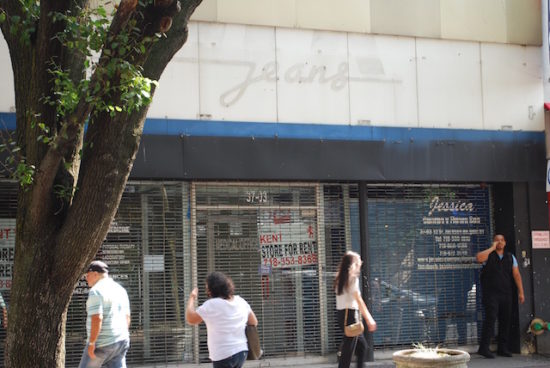
As the tour walked up 74th Street, Neha asked the students to look around and notice the types of businesses we were passing by. Large glass windows displayed boastful mannequins draped in beautiful, albeit sometimes gaudy, traditional clothing, from saris to kurtas. Lavish displays of gold jewelry highlighted the highbrow immigrant hustle that was still accompanied by the homeland touch of worker auctioneers on the street encouraging you to go in the store. We also passed South Asian grocery stores and restaurants, and as we turned on to 37th Avenue, we passed by street vendors selling religious items, scarves, and incense.
We walked up 37th Avenue and stopped at the corner of 77th Street, in front of the orange-brown brick building that is the Jewish Community Center. Here, Neha talked about everything from Chhaya’s annual Chatpali Mela (a South Asian festival), to the annual Queens Pride parade that marches down 37th Avenue. Neha looked at me as she spoke of Queens Pride being the “best” gay pride celebration in New York City. I smiled and wholeheartedly agreed as the students grinned and giggled with us. I have celebrated Queens Pride with community for years; to have immigrant LGBT communities celebrated in an immigrant community is an amazing and affirming experience.
Neha also talked about private and public spaces in Jackson Heights and how most co-ops have private gardens. “The neighborhood doesn’t have a lot of green space. And all the green spaces it does have are not for the community,” Neha said.
“There are no parks?” a student asked.
“There are small playgrounds. But they are cement – there’s no grass. There are no green spaces,” Neha replied.
As we continued walking up 37th Avenue towards 82nd Street Neha said, “[You take a] three-minute walk [and] we’re on another continent. That’s Jackson Heights.”
We stopped at the corner of 37th Avenue and 82nd Street, named Calle Colombia Way, recognizing the significant Colombian population of Jackson Heights. Here, Josselyn spoke about the Business Improvement District or BID – an issue that was closely followed in the documentary In Jackson Heights. One scene from the film depicts a conversation in a local hair salon business about the changes taking place in the neighborhood:
“Remember that Manhattan is already packed,” a man with a grey mustache says in Spanish. “Wealthy people are coming to Jackson Heights, a place they wouldn’t have looked at before.”
“Here it’s authentic,” a Latino man in a purple shirt continues. “That’s what the Business Improvement District will destroy.”
The New York Times review of In Jackson Heights acknowledged the issue somewhat as well: “Mr. Wiseman’s latest documentary is a movingly principled, political look at a dynamic neighborhood in which older waves of pioneers make room for new, amid creeping gentrification.”
According to Josselyn, this “creeping gentrification” is directly linked to the BID.
Josselyn explained that QNU sees the rhetoric of the BID – “cleaning up and making improvements for the community” – as a code for displacing existing communities.
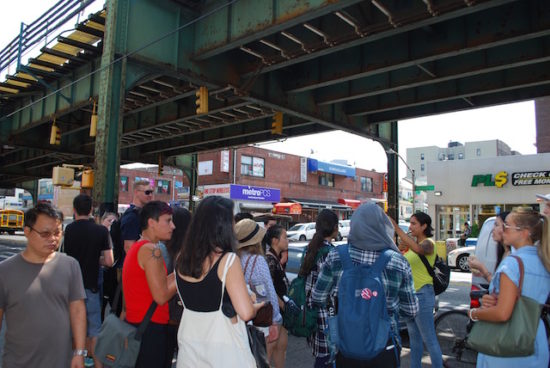
“This is already the BID,” Josselyn said, pointing down 82nd Street. “There is a BID in place for 82nd Street between Baxter and 37th. We’re trying to fight off the expansion that would be between 82nd and 103rd. That would be the largest BID in the city.”
82nd St. represents the biggest area impacted by the BID. There are corporate chains all along the street – GAP, Foot Locker, Burger King, McDonalds, Payless Shoe Store, GNC, Bank of America, Chase Bank, Game Stop, and Sketchers to name a few. “This street to me looks like a mini-mall or like a street you would see anywhere else,” Neha said. “It’s not the Jackson Heights I grew up with. She pointed to a Banana Republic branch, which she said came to the neighborhood only about a year ago. “Before Banana Republic, that used to be discount store.”
One of the students wanted to know more about the BID. “I was wondering if you could speak about the organizational structure of the BID,” one of the students asked.
“They have a board,” Josselyn replied. “Traditionally, the board is made up of property owners. That’s where the conflict of interest is.”
She explained that a lot of immigrants rent from property owners and don’t actually own the location of their businesses. All taxes due to the BID gets passed on to the renter; property owners simply raise the rent to meet the cost of fees or taxes associated with the BID.
“That’s where you see the displacement, where businesses can’t afford to stay afloat. You see big corporations like Banana Republic coming in. Often times, you’ll see four little businesses that were taking up a corner that will get kicked out and you’ll have one big corporation that can cover the cost for everything for those four lots,” she said.
Josselyn said that QNU has been very vocal and has organized many protests to voice concerns about the expansion of the BID. “What’s interesting about the proposal is that because we were pushing back so much on it, they changed the makeup of the board to make it more representative of the community.”
Although some seats on the board have been reserved for community members, Josselyn said QNU still does not support the BID. She said QNU believes that a lot of the services that the BID would provide, the city should already be providing. She said the money community members pay through taxes should result in adequate services rather than the city choosing to invest in a “half-public, half-private organization that often isn’t from the community and hasn’t spent time in the community.”
As the tour continued down to Roosevelt Avenue, I chatted with the professor of the class, asking how their other stops in New York City have been and if similar issues were present in Toronto. She said how the previous day they were at Fulton Mall in Brooklyn and how they heard similar issues around commercial gentrification.
“‘A lot of people are just trying to make a living – undocumented folks, women who come here – [it’s] the only job they can get to support their families – and they are criminalized.'”
“A lot of neighborhoods in Toronto are now more expensive than New York which is just shocking. It’s been so different – It’s horrible, right?,” the professor said.
“The speed of financialization in Toronto has been so bad. So basically the inner city is so white and professional and all the immigrant and racialized communities have been displaced to the periphery – yeah, it’s pretty dramatic though we haven’t gone through the re-zoning you guys have gone through that have just been so fast.”
We all stopped at the corner of 82nd Street and Roosevelt; the loud 7 train thundering above us on elevated tracks. Neha described Roosevelt Avenue as a place with a lot of energy, a lot of commercial interactions, a lot of bars, and a place where you’ll hear a lot of music, like bachata and cumbia. She said a lot of people come to dance and hang out – people, like day laborers, who have “left communities and families back home, so they are looking for something familiar” whether that it is “the music or football games that they can watch.”
As we all huddled on the corner, Neha talked about policing of street vendors. “It’s becoming harder and harder for people to vend,” she said. Josselyn spoke of the various types of street vendors in the neighborhood and along Roosevelt Avenue – from people selling icies out of coolers and tamales from carts, to people selling tacos and other food from trucks or pushcarts.
She explained that there is a cap on licenses for vendors and the demand far outweighs the supply. There are also many regulations to navigate depending on what type of license one has, such as what can be sold and the distance to be maintained from “brick and mortar” businesses.
“It just sucks,” Josselyn said. “A lot of people are just trying to make a living – undocumented folks, women who come here – [it’s] the only job they can get to support their families – and they are criminalized.”
Josselyn described how this informs QNU’s work. QNU conducts “Know Your Rights” outreach and works closely with organizations like Vamos Unidos that directly support and organize street vendors. “There are two precincts in the area that have counter terrorism units here and immigration further down that way,” Josselyn said of Jackson Heights. “We do know your rights, but your rights look different based on where you fall in the spectrum of the police and how they criminalize you.”
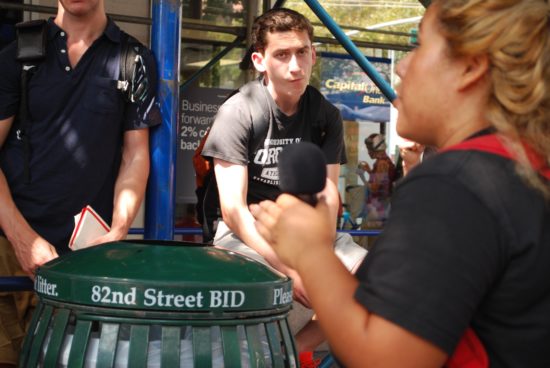
Neha said that complaints to clean up Roosevelt Avenue often target street vendors. She, however, said the complaints are “questionable.” “Who is it really bothering?” she asked.
The students bunched into clusters of two and four making their way down Roosevelt Avenue back to Diversity Plaza. While we were walking, one student asked Neha if she still lived in the neighborhood.
“I’m in Corona,” she responded, a neighborhood just east of Jackson Heights. She said she keeps getting pushed away from the city but might come back to Jackson Heights if she can find “something reasonable” in terms of rent.
“It’s home,” she expressed. “I see the youth I work with all the time. I can buy my groceries. There’s references that I understand. You always want to stay close to them,” she said.
We passed by gay bars on Roosevelt Avenue and Neha shared that Jackson Heights has the largest Latinx gay community after San Francisco and Miami. She also pointed out Arepa Lady, a small restaurant owned by a woman who used to sell arepas as a street vendor.
As we arrived back at Diversity Plaza, the tour concluded with some closing remarks and a Q&A. Josselyn said Jackson Heights was predominantly white just 40 years ago and that migration is a reality and neighborhoods change. She pointed out, though, that power hasn’t really shifted, even though the demographics have changed, in terms of who owns land and who is on the community board who advocates for and make changes in the neighborhood. She spoke of the commodification and romanticization of diversity – how for outsiders moving in, it is simply beautiful, glossing over the struggles of people already here.
The questions from students reflected an understanding of the analysis Josselyn shared, regarding consumption of diversity being different from support for diverse communities. They asked about what would need to happen for rents to stay affordable, what the literature looked like for the “Know Your Rights” work that QNU conducted with regards to interactions with the police, and if there were any laws in place around multi-lingual signage (referencing Ontario’s bilingual laws around English and French).
These questions lend themselves to a systemic analysis of forces that shape the neighborhood, in terms of laws and policies but also the powerful resistance and organizing happening simultaneously to push back against marginalization and build power of immigrant communities.
“For outsiders moving into Jackson Heights, it is simply beautiful, which glosses over the struggles of people already there.”
It is no surprise that Jackson Heights was on the list of neighborhoods in New York City that this class examining gentrification came to. The definition of gentrification that I refer to is that of Just Cause, a social justice organization in the San Francisco Bay Area:
“We define gentrification as a profit-driven racial and class reconfiguration of urban, working-class and communities of color that have suffered from a history of disinvestment and abandonment. The process is characterized by declines in the number of low-income, people of color in neighborhoods that begin to cater to higher-income workers willing to pay higher rents. Gentrification is driven by private developers, landlords, businesses, and corporations, and supported by the government through policies that facilitate the process of displacement, often in the form of public subsidies. Gentrification happens in areas where commercial and residential land is cheap, relative to other areas in the city and region, and where the potential to turn a profit either through repurposing existing structures or building new ones is great.
Afterwards, I saw some of the students eating at Arepa Lady and we chatted about their impressions of the tour. One student, Tom Willington, said that one of their academic readings discussed co-op housing and Jackson Heights as a “middle-class suburban commuter city.” He said that to hear about Irish and Italian immigrants being a part of the history of co-op buildings and to actually be in the neighborhood and have a visceral impression of the spatial manifestation of different waves of immigration was striking.
As for me, I was surprised to hear that there was an academic writing about Jackson Heights and glad that the People’s Walking Tour lifted up stories and knowledge that might not otherwise be heard. Personally, as a child of low-income immigrants (and as someone who migrated to India and back in adolescence) I am deeply grateful to live in a neighborhood where the “norm” in terms of language, clothes, food, and music is shaped by immigrant communities.
In the looming era of Donald Trump, I am also scared for what lies ahead; in Jackson Heights, one thing is for sure: We will continue to organize for safety and dignity, no matter what.

